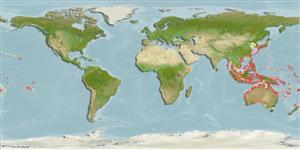>
Elopiformes (Tarpons and tenpounders) >
Elopidae (Tenpounders)
Etymology: Elops: Greek, ellops = a kind of serpent (Ref. 45335).
More on author: Regan.
Environment: milieu / climate zone / depth range / distribution range
นิเวศวิทยา
เกี่ยวกับทะเล,น้ำเค็ม; น้ำจืด; กร่อย; ปลาที่อพยพจากแหล่งน้ำเค็มไปวางไข่ในแหล่งน้ำจืด (Ref. 51243); ระดับความลึก 1 - 30 m (Ref. 6898). Tropical; 41°N - 40°S, 92°E - 138°W
Indo-Pacific: from the Andaman Sea in the Eastern Indian Ocean to Western Australia and in the Pacific, from southern Japan to New South Wales and New Caledonia; throughout most of Oceania to the Hawaiian Is., Society Is., and Tuamotus (Ref. 86689). Currently treated as a single species, but this status should be considered provisional. Further studies may reveal a complex of closely related species, as in the case of Albula.
ขนาด / น้ำหนัก / Age
Maturity: Lm ? range ? - ? cm
Max length : 120 cm SL เพศผู้/กระเทย; (Ref. 44894); common length : 50.0 cm SL เพศผู้/กระเทย; (Ref. 10983); น้ำหนักสูงสุดที่มีการรายงาน: 10.1 kg (Ref. 6736)
เงี่ยงครีบหลัง (รวม): 0; ก้านครีบอ่อนที่หาง (รวม): 23-27; เงี่ยงครีบก้น 0; ก้านครีบอ่อนที่ก้น: 14 - 18. A gular plate present between arms of lower jaw. Branchiostegal rays numerous, approximately 20-25. All fins without spines. Scales very small, approximately 100 in lateral line.
A coastal fish, commonly entering lagoon, bays, and estuaries (including fishponds) (Ref. 2847, 58302), particularly around mangroves (Ref. 44894). Sometimes enters freshwater streams, but does not penetrate very far inland (Ref. 2847). Benthopelagic (Ref. 58302). Younger fish often penetrate the lower freshwater reaches of rivers (Ref. 44894). An active swimmer, commonly traveling in schools in open water. Feeds on various fishes and crustaceans. Little detailed knowledge exists of its biology. Has a leptocephalus larva. Spawning takes place offshore and young larvae are found in the open sea, moving close to shore as they develop. Juveniles commonly found in salt marshes, canals, and tidal streams. Marketed fresh or frozen; in some places ground up as fish meal. A good sport fish on light tackle, striking a variety of artificial lures as well as live shrimp or baitfish. No separate statistics available. (Ref. 10983).
Life cycle and mating behavior
วัยเจริญพันธุ์ | การสืบพันธุ์ | การวางไข่ | เซลสืบพันธ์ของเพศเมีย(ไข่) | ความดกของไข่ | ตัวอ่อน
Smith, D.G., 1997. Elopidae. Ladyfishes, tenpounders. p. 1619-1620. In K.E. Carpenter and V.H. Niem (eds.) FAO species identification guide for fishery purposes. The living marine resources of the WCP. Vol. 3. Batoid fishes, chimaeras and bony fishes part 1 (Elopidae to Linophrynidae). FAO, Rome. (Ref. 10983)
IUCN Red List Status (Ref. 130435)
Human uses
การประมง: การค้า; การตกปลาเป็นกีฬา: ใช่
ข้อมูลเพิ่มเติม
ชื่อสามัญชื่อพ้องกลไกการเผาผลาญพลังงานผู้ล่าการศึกษาเกี่ยวกับผลกระทบของสารประกอบทางเคมีที่เป็นอันตรายต่อสิ่งมีชีวิต ประชากร และสิ่งแวดล้อมการสืบพันธุ์วัยเจริญพันธุ์การวางไข่การรวมกลุ่มวางไข่ความดกของไข่เซลสืบพันธ์ของเพศเมีย(ไข่)Egg development
อ้างอิงการเพาะเลี้ยงสัตว์น้ำประวัติการเพาะเลี้ยงสัตว์น้ำสายพันธุ์พันธุศาสตร์ElectrophoresesอัตราพันธุกรรมโรคการแปรรูปNutrientsMass conversion
เครื่องมือ
Special reports
Download XML
แหล่งที่มาจากอินเตอร์เน็ต
Estimates based on models
Preferred temperature (Ref.
123201): 24.5 - 29.3, mean 28.6 °C (based on 2710 cells).
Phylogenetic diversity index (Ref.
82804): PD
50 = 0.5176 [Uniqueness, from 0.5 = low to 2.0 = high].
Bayesian length-weight: a=0.00589 (0.00256 - 0.01357), b=2.99 (2.79 - 3.19), in cm total length, based on LWR estimates for this (Sub)family-body shape (Ref.
93245).
ระดับชั้นอาหาร (Ref.
69278): 4.0 ±0.62 se; based on food items.
ความสามารถในการกลับคืนสู่ปกติ (Ref.
120179): ต่ำ, เวลาต่ำสุดที่จะทำให้ประชากรเพิ่มขึ้นเป็น 2 เท่าใช้เวลา 4.5 - 14 ปี (Preliminary K or Fecundity.).
Fishing Vulnerability (Ref.
59153): Very high vulnerability (88 of 100).
Nutrients (Ref.
124155): Calcium = 77.5 [47.6, 137.7] mg/100g; Iron = 1.11 [0.70, 1.81] mg/100g; Protein = 16.8 [14.3, 19.8] %; Omega3 = 0.162 [0.090, 0.301] g/100g; Selenium = 50.9 [26.7, 100.8] μg/100g; VitaminA = 18.3 [7.4, 44.7] μg/100g; Zinc = 0.994 [0.727, 1.368] mg/100g (wet weight);
